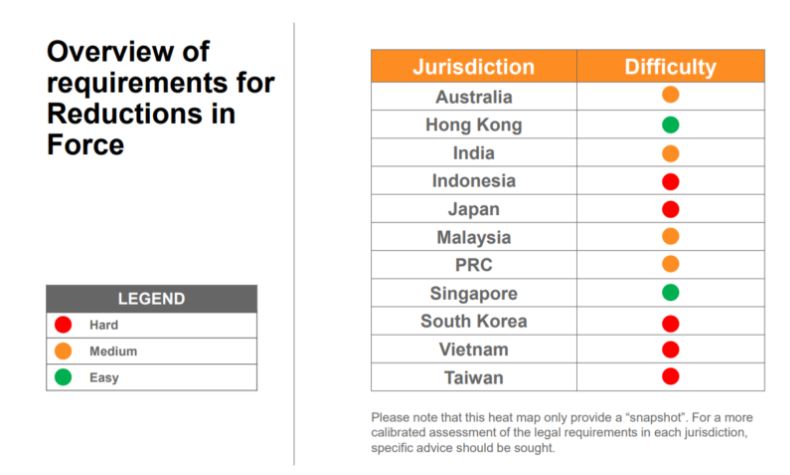Seyfarth recently hosted a webinar entitled Asia-Pacific Reductions in Force: Ten Things to Look Out for, addressing the practical issues employers should be aware of when restructuring in APAC. We shared examples across a variety of countries in the region, including Australia, Hong Kong, India, Indonesia, Japan, Korea, Malaysia, the People's Republic of China, Singapore, and Vietnam, among others.
Given the interest in this subject matter, we bring you this series of four blogs that break down highlights of our top ten things to look out for. Please read on for Part 1, which covers our first consideration – planning and strategy timing.
- Planning and strategy timing
The key question for a reduction in force (RIF) is, how can companies reach their business objectives efficiently and effectively while avoiding legal and cultural pitfalls? RIFs in APAC, in particular, can be challenging because the requirements and local nuances vary vastly among jurisdictions, which may affect the overall planning and strategy timing. Therefore, it is crucial not only to understand the laws of the jurisdictions in which RIFs are intended, but also to capture the right level of information upfront, so that there can be a proper assessment of whether, and if so, what legal requirements are applicable or triggered.
In APAC, the RIF legal framework can be very different between employer-friendly jurisdictions and employee-friendly jurisdictions. Broadly speaking, the ease of carrying out RIFs in different APAC jurisdictions can be categorised into three levels – easy (green), medium (amber), and hard (red) – which we illustrate for some common APAC countries in the heat map in Figure 1.

Figure 1 – RIF difficulty heatmap in APAC
In addition to the importance of understanding the legal requirements of the impacted jurisdictions, other key considerations in relation to planning and strategy include:
- Timing. Often, businesses will have an intended timeline for a RIF – for example, before the end of a financial year, or before or after the completion of an M&A project. Therefore, it is important to allow for sufficient time to complete necessary legal processes before the intended RIF date. For countries where the process of a RIF would be lengthier (e.g. Indonesia, Taiwan and India), the legal process may have to begin sooner than other jurisdictions such as Hong Kong, where an immediate RIF is possible. Where there are protections over specific classes of employees against termination of employment (e.g. pregnant or sick employees), this will also impact the planning around timing.
- Communication. The overall timing will also impact the communication plan. For example, if you need to stagger the timing of the RIFs in different jurisdictions, how do you manage employee expectations? A clear communication plan upfront can help manage those expectations effectively throughout the RIF process. One-size-fits-all approaches should be avoided as there are different legal and cultural considerations to bear in mind across the region. With the communications strategy, it is important to consider the who (e.g. who is most appropriate to deliver the communication – HR, management, in-house counsel, etc.?) and the how ( e.g. via townhall, email, letter, in-person/zoom meeting, board resolution, individual or group meeting, etc.?).
- Costs and budgeting. Costs and budgeting concerns can affect the way in which companies approach a RIF in APAC. If the key driver is to keep costs as low as possible, a company may wish to follow the statutory process in each APAC jurisdiction in order only to pay the statutory minimum termination payments to affected employees – however, in some jurisdictions, this can take a long time, and disgruntled employees could make complaints or raise claims if they are not satisfied with the process. If the key driver is to complete the APAC RIF promptly or by a fixed date and to minimise any legal risks, a company may prefer to consider the mutual separation route under which they will provide an ex-gratia payment to affected employees in return for them waiving their rights to bring any claims against the company – this will obviously cost more money though. In some jurisdictions, such as Japan, it may be the market norm to offer an enhanced package to employees, and there may be market benchmarks. Therefore, apart from looking at the legal requirements, market practice and expectations may also affect the costs and budgeting of the RIF.
- Business case and objectives. Finally, the business case and objectives are crucial elements to a RIF. For some jurisdictions, a RIF cannot be justified without a proper business case being in place (e.g. showing that the company is experiencing financial difficulties), whereas for other jurisdictions an explanation for the RIF is only required if an employee challenges the RIF in court (we'll address this in greater detail in our next blog). Business objectives around what the company wants to achieve and what roles, skills, and experience it requires going forward will affect how the RIF is conducted and how employees are selected for redundancy. While planning a RIF, thought should also be given to how to avoid, as much as possible, disruption to the rest of the business. Communication with the remaining employees is important to relieve any concerns, assist with retention, and ensure continued productivity.
The key takeaway from the planning and strategy stage of a RIF is not to look at all of these elements in a vacuum, but to understand the whole landscape in which the RIF will happen in order to plan appropriately and ensure a smooth process that achieves the company's goals.
Please stay tuned for Part 2 of our series, where we'll examine numbers 2–4 in our Top Ten list: Rationale for Restructure, Selection and Redeployment, and Consultation.
This post was originally published on Seyfarth's blog Employment Law Lookout: Insights for Management and is reproduced in its entirety here.
The content of this article is intended to provide a general guide to the subject matter. Specialist advice should be sought about your specific circumstances.




